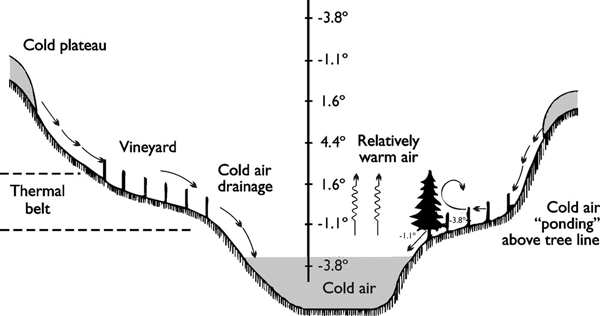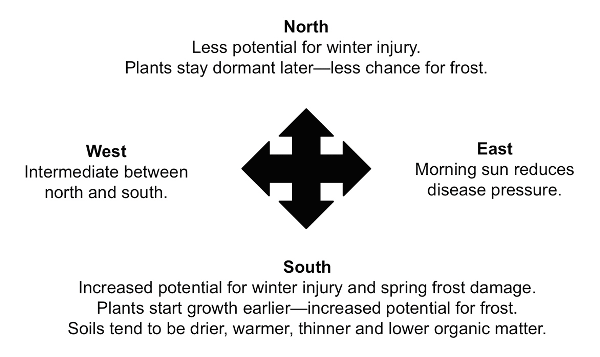General
The southern region of the US includes a range of climates with elevations that begin at sea level and reach 3,000 feet. This wide range of climates enables growers to produce raspberries in the cooler regions and blackberries in the warmer regions from June through October. (See Tables 2-1 and 2-2 to determine the best cultivars for your farm and marketing strategy.)
Site selection has components that can be modified such as water availability, soil drainage, fertility, pH, and organic matter. Components that cannot be changed easily are slope, sun exposure, duration, seasonally extreme temperatures, site history, and nearby land development. Site topography affects suitability for the growing of fruit crops, especially the on-site temperatures. Sites that are elevated above the surrounding terrain offer some natural protection (thermal belt) from radiation frosts and disease (Figure 3-1). Frosts and fogs tend to first settle in the lower areas. Planting on top of a hill in a windy area may be undesirable due to the possibility of plant and fruit damage from desiccation and cane breakage.
In general, a gentle, uniform slope is most desirable for fruit crops. Steep slopes (greater than 12 to 15 degrees) present challenges in establishing and maintaining the planting and can be hazardous when operating equipment. Soil on south-facing slopes tends to be hotter, dryer, and thinner, and have lower organic matter content than those on north to northeastern-facing slopes. The potential for winter injury and frost damage tends to be higher on south-facing slopes as well. Although fruit may ripen earlier on a south-facing slope, the potential for crop loss is higher. Crops on slopes with an eastern direction dry more quickly in the morning due to the earlier sunlight exposure. Northern-facing slopes will produce fruit later in the season when the fruit is less likely to be injured by spring frosts (see Figure 3-2).
Both blackberries and raspberries grow best with full sun and well-drained soil. The most suitable soils are high in organic matter (more than 2%) and have a pH of 6.0 to 6.5. Sandy loam or loam soils are best. Blackberries and raspberries can be grown in sandy soils with a good irrigation system. In general, their root systems do not tolerate wet soils. Avoid clay and poorly drained soils in locations with high water tables or in areas prone to flooding. Raised beds can, in part, compensate for a periodically wet site.
Avoid sites where strong hot summer winds or cold winter winds prevail. Hot summer winds can dry the fruit, cause sunscald, and increase the plants’ water needs. In addition, fruit size and plant growth will be compromised. Cold winter winds can cause winter injury, which often results in cane breakage, cane dieback, or both. Windbreaks, which are linear plantings of trees and shrubs, can reduce air movement if you suspect that it may damage your crop. Keep in mind, however, that good air circulation keeps disease problems to a minimum.
New caneberry plantings should be isolated as much as possible from wild raspberry and blackberry plants, which harbor diseases and insects that can devastate your crop. New plantings should be at least 100 to 200 yards from wild caneberries. Additional site recommendations related to insects and diseases can be found in the Southeast Regional Caneberries Integrated Management Guide, located on the Southern Region Small Fruits Consortium’s IPM/Production Guides webpage.
Blackberry
Blackberries grow best in warm, temperate regions and are generally considered less hardy than raspberries. In the Southeast plants flower from March in southern Georgia to May in the Appalachian Mountains, and bloom over a long period. Because blackberries flower later than many other fruit crops, damage to flowers from spring frosts and freezes is a less frequent problem but can occur throughout the region. In higher elevations where the winters are more severe, the use of hardy cultivars with high chilling requirements, and planting of blackberries on hillsides above frost pockets will help to avoid damage to the canes from the cold. In general, blackberries are recommended for areas where winter temperatures stay above 10°F.
Raspberry
Raspberry plants perform best where the growing season is long and summer temperatures are mild. They also grow best where winters are uniformly cool and long enough to satisfy their chilling requirement. These conditions are not typical of most areas in the southern US. With careful selection of cultivars, however, and good cultural practices, raspberries can be grown successfully despite the odds. The best growing conditions in the southern US exist in the moderate elevations of the Appalachian Mountains, about 2000 to 3000 ft. The summer temperatures are not too hot, and the winter temperatures do not fluctuate as much as in the lower elevations.
Row Orientation
Wherever possible, orient rows north to south. Fruits and foliage will receive more uniform sunlight exposure throughout the day with this orientation than with other row directions. Problems with sunscald, which often occurs on the south side of east-west oriented rows, will be lessened. However, the desired floor management system for caneberry plantings includes a 4-ft wide clean strip in the row, plus a closely mowed sod strip between rows. Thus, rows on sloping ground should be oriented perpendicular to the direction of the slope. This orientation allows for better erosion control, more simple irrigation designs, and greater precision in pesticide applications than working up and down hills.
In the piedmont and mountain regions, fescue is an excellent choice for a perennial ground cover between rows. Planting on a contour, while desirable in other circumstances, presents special problems for constructing and maintaining trellises. Instead, consider planting straight rows, stopping the row when the slope within it becomes too great, and restarting the row in a slightly different direction. Leaving a gap between the ends of the trellises allows for air drainage out of the field and provides room for turning equipment around within the planting.
Publication date: Feb. 23, 2023
AG-697
Other Publications in Southeast Regional Caneberry Production Guide
- Introduction
- Cultivars
- Site Selection
- Site Preparation, Planting, and Establishment
- Plant Growth
- Pruning and Training
- Trellis Systems
- Tunnel Production
- Water Management
- Integrated Pest Management and Pollination
- Fertility Management
- Fruit Development
- Harvesting and Postharvest Management
- Food Safety Considerations for Caneberry Production
N.C. Cooperative Extension prohibits discrimination and harassment regardless of age, color, disability, family and marital status, gender identity, national origin, political beliefs, race, religion, sex (including pregnancy), sexual orientation and veteran status.


